Not the best looking job but it works. Cleaned and scuffed well was key. Solder would stick to tabs but not the cell as I believe the cell would not
get hot enough. Took a old soldering iron and heated the tip with a torch to cherry red and used that to heat the bottom of cell before trying to
solder. It seemed to help as it stuck, how well time will tell. Built up solder then filed it off to fit tight to lower half of case when i put it back
together. Hopefully it will keep it in contact if the solder fails.. Thanks for all the advise.

get hot enough. Took a old soldering iron and heated the tip with a torch to cherry red and used that to heat the bottom of cell before trying to
solder. It seemed to help as it stuck, how well time will tell. Built up solder then filed it off to fit tight to lower half of case when i put it back
together. Hopefully it will keep it in contact if the solder fails.. Thanks for all the advise.


